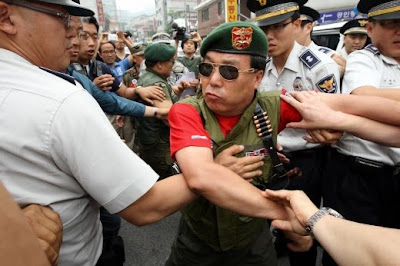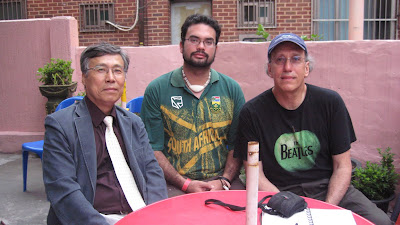 The chairman of the Mugeonri village committee discovers the gate is unlocked and inside we went. On the left used to be rice paddies and the U.S. Army now drives tanks through the mountains and fires shells in the direction of North Korea
The chairman of the Mugeonri village committee discovers the gate is unlocked and inside we went. On the left used to be rice paddies and the U.S. Army now drives tanks through the mountains and fires shells in the direction of North Korea Right-wingers in South Korea have been busy in recent days after progressives sent a letter to the UN's Security Council questioning the "official story" about the sinking of the Cheonan Navy ship
Right-wingers in South Korea have been busy in recent days after progressives sent a letter to the UN's Security Council questioning the "official story" about the sinking of the Cheonan Navy ship Meeting here with Dr. Chung (left) whose parents were survivors of the massacre at No Gun Ri during the Korean War
Meeting here with Dr. Chung (left) whose parents were survivors of the massacre at No Gun Ri during the Korean War Our delegation getting ready to board the bus in Gangjeong village for trip to airport and return to Seoul. I've got on my Korean World Cup soccer shirt that illustrates many activists hopes that the teams from the North and South would end up in the semi-finals against one another - a reunification activists dream come true. But unlikely to happen this time.
Our delegation getting ready to board the bus in Gangjeong village for trip to airport and return to Seoul. I've got on my Korean World Cup soccer shirt that illustrates many activists hopes that the teams from the North and South would end up in the semi-finals against one another - a reunification activists dream come true. But unlikely to happen this time.* On our last day in South Korea our thinned out delegation took a trip north to within an hours drive of the DMZ to a village called Mugeonri. Since 1979 the U.S. military has been scooping up large holdings of rice farm land and complete villages in the area in order to create a huge military training area for tanks and armored vehicles. The people in this area have lived here for 400 years and have relatives just over the border in North Korea. The process of having their lands stolen from them is doubly sad because not only do they lose their sacred farms and communities but the military maneuvers that are carried out there are aimed toward North Korea and any attack is sure to kill their relatives.
Each time there is a U.S. military war game in the tree-lined mountains surrounding their declining village populations, 30-60 tanks and armored vehicles trundle through their streets in the early morning or late at night. In 2002 two local school girls were ran over by U.S. Army tanks as they walked to a birthday party. Those responsible for running them down were never punished and the killings became a huge controversy all across South Korea.
Led by the chairman of the local village committee, and a leader from SPARK, we were driven around to see the growing area that makes up the training fields. When we came to a padlocked iron gate blocking our entry onto a road through the mountains, the local chairman discovered that the gate was not actually locked. So he threw open the gate and we piled back into his van and into the mountainous war rehearsal zone we drove. Soon we came to several military camps, set up with tents and South Korean Army soldiers in full battle gear. We got out saying we wanted to see their sacred tree that has bark that turns water blue. The soldiers kept shouting at us to move on and one of them had his machine gun pointed at us the entire time we were outside the van pointing to the tree on a hill just beyond their war camp.
We also stopped by the large tombstone honoring the two teenage girls and heard the story that it had been purchased by the soldiers from the U.S. Army 2nd Infantry Division whose personnel had run them over. Local Korean activists have requested the Army remove the tombstone so that the community can replace it with one of their own but so far the Army has ignored their request.
* I am writing this from the airport in Washington DC where I have a five-hour wait to catch my plane back to Maine. I did not sleep during the 13 hour flight from Korea back to the U.S. and watched seven movies. My mind is mush now and doing this blog is a chore.
* While on Jeju Island we watched a half-hour video and I was struck by one phrase: "We don't know where our ending point is....but we do know that when there is a start there is an end."
* We had alot of fun on the trip and of particular interest was Michael Lujan Bevacqua's quest to count the number of Dunkin Donut shops along our journey. I think he hit about 20 in all, and while a nice joke, it made the important point about the corporate colonization of South Korea. Michael, from Guam, has a blog where he has posted photos and his reflections throughout our trip. You can find it here
* Dr. Chung (in the photo above who we met the night before we left) is the chairman of the citizens committee to bring justice to those who were massacred at No Gun Ri on July 26-29, 1950. He and his father (both his parents are survivors of the massacre that killed up to 400 innocent civilians) have worked for years to bring the massacre to light and ultimately proved that the carnage had been ordered by high-level U.S. military brass. Recently a mainstream South Korean TV network did a documentary about No Gun Ri and he presented it to me so it could be shown at the national Veterans for Peace 25th anniversary convention that will be held in Portland, Maine on August 25-29.
* The big story in Korea these days though is the sinking of the South Korean Navy boat called the Cheonan. Progressive activists from an organization called the People’s Solidarity for Participatory Democracy (PSPD) sent a letter to the UN's Security Council seriously questioning the South Korean right-wing President Lee's "official" account that puts the blame on North Korea. PSPD also calls for a real international investigation of the incident.
One of the Naval experts who was on the South Korean investigative committee disagreed with the formal findings of the final report and maintains that the ship was grounded (and broke apart) in rough shallow waters during U.S.-South Korean military exercises that put these ships near North Korean waters.
South Korean President Lee is furious with PSPD for "unilaterally" approaching the UN Security Council and has helped stoke up the anger of right-wingers who have been daily attacking the offices of PSPD in Seoul. You can read an interesting article in a South Korean newspaper (in English) here
You can also read a letter from SPARK to the UN Security Council here
No comments:
Post a Comment